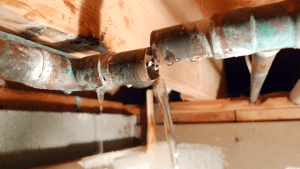What're your thoughts with regards to Leaking water lines?

Early discovery of leaking water lines can alleviate a potential calamity. Some tiny water leakages may not be noticeable.
1. Examine the Water Meter
Every home has a water meter. Examining it is a guaranteed manner in which helps you uncover leaks. For beginners, turn off all the water sources. Make certain nobody will certainly flush, utilize the tap, shower, run the washing machine or dish washer. From there, go to the meter as well as watch if it will certainly change. Considering that no one is using it, there need to be no movements. That suggests a fast-moving leakage if it moves. If you discover no adjustments, wait an hour or two as well as examine back again. This implies you might have a slow-moving leakage that can even be underground.
2. Examine Water Intake
If you spot sudden changes, despite your intake being the very same, it suggests that you have leakages in your plumbing system. An abrupt spike in your costs shows a fast-moving leakage.
On the other hand, a constant boost every month, despite the exact same practices, shows you have a sluggish leak that's additionally gradually intensifying. Call a plumber to extensively examine your building, specifically if you really feel a warm location on your flooring with piping beneath.
3. Do a Food Coloring Test
When it comes to water intake, 30% originates from bathrooms. Examination to see if they are running properly. Decline flecks of food color in the container as well as wait 10 minutes. If the shade in some way infiltrates your bowl throughout that time without flushing, there's a leak between the container as well as bowl.
4. Asses Outside Lines
Do not forget to examine your outside water lines also. Test faucets by connecting a garden pipe. Ought to water permeate out of the connection, you have a loosened rubber gasket. Replace this as well as guarantee all links are tight. If you have actually got a sprinkler system, it will certainly help get it properly analyzed and also preserved each year. One small leakage can waste tons of water and also spike your water expense.
5. Assess the circumstance and also inspect
Property owners must make it a habit to check under the sink counters as well as also inside closets for any kind of bad odor or mold development. These two red flags show a leak so punctual focus is called for. Doing regular assessments, even bi-annually, can save you from a major problem.
If you know your home is already old, keep a watchful eye on your heaters, hose pipes, pipes etc. Check for discolorations and also weakening as most appliances and pipelines have a life span. They will certainly additionally normally degrade as a result of deterioration. If you presume dripping water lines in your plumbing system, do not wait on it to intensify. Call a specialist plumber right away so you do not wind up with a terrible mess in your home.
Early detection of leaking water lines can alleviate a possible disaster. Some little water leaks may not be noticeable. Examining it is a surefire way that assists you uncover leakages. One tiny leak can lose bunches of water and spike your water expense.
If you believe leaking water lines in your plumbing system, do not wait for it to rise.
WARNING SIGNS OF WATER LEAKAGE BEHIND THE WALL
PERSISTENT MUSTY ODORS
As water slowly drips from a leaky pipe inside the wall, flooring and sheetrock stay damp and develop an odor similar to wet cardboard. It generates a musty smell that can help you find hidden leaks.
MOLD IN UNUSUAL AREAS
Mold usually grows in wet areas like kitchens, baths and laundry rooms. If you spot the stuff on walls or baseboards in other rooms of the house, it’s a good indicator of undetected water leaks.
STAINS THAT GROW
When mold thrives around a leaky pipe, it sometimes takes hold on the inside surface of the affected wall. A growing stain on otherwise clean sheetrock is often your sign of a hidden plumbing problem.
PEELING OR BUBBLING WALLPAPER / PAINT
This clue is easy to miss in rooms that don’t get much use. When you see wallpaper separating along seams or paint bubbling or flaking off the wall, blame sheetrock that stays wet because of an undetected leak.
BUCKLED CEILINGS AND STAINED FLOORS
If ceilings or floors in bathrooms, kitchens or laundry areas develop structural problems, don’t rule out constant damp inside the walls. Wet sheetrock can affect adjacent framing, flooring and ceilings.
https://www.servicemasterbyzaba.com/blog/how-to-detect-water-leakage-in-walls/

I'm just very taken with Leaking water lines and I am assuming you enjoyed reading our piece. If you enjoyed reading our blog posting if you please remember to share it. Thank you for your time invested reading it.